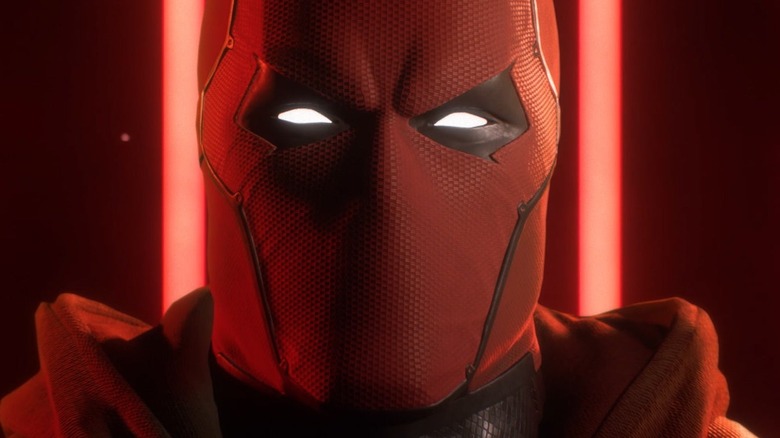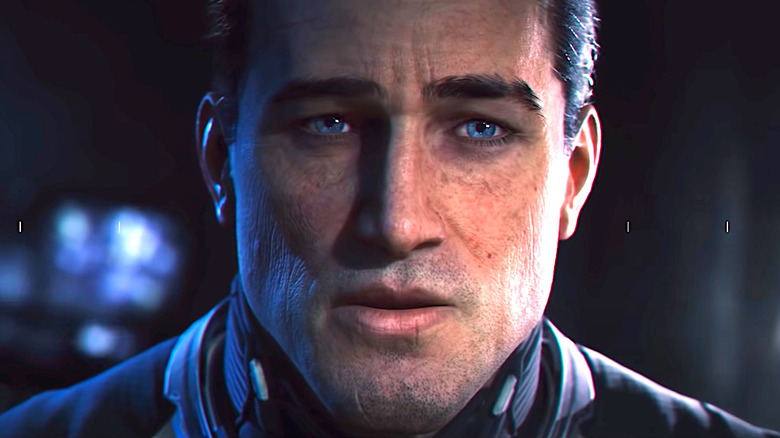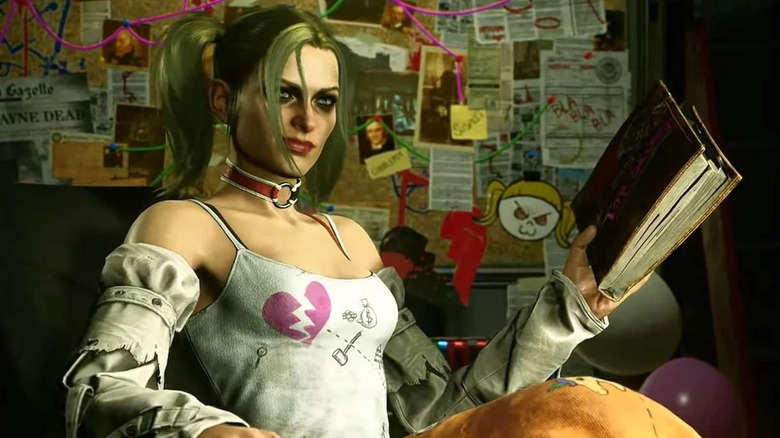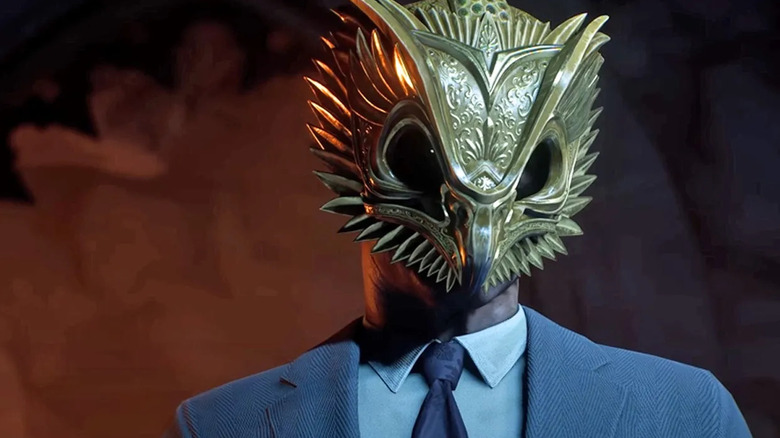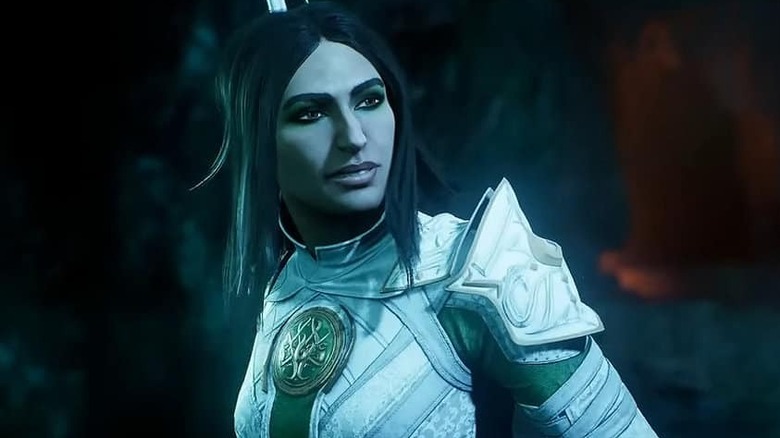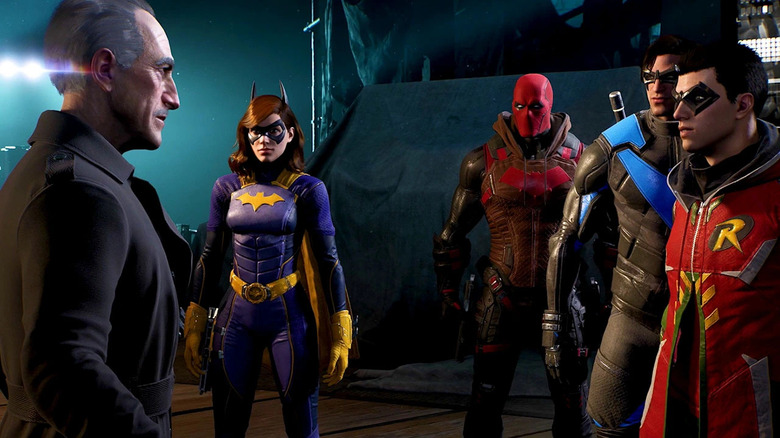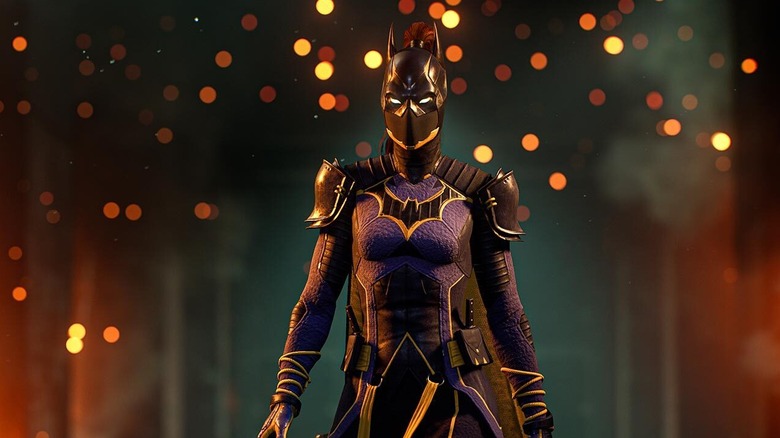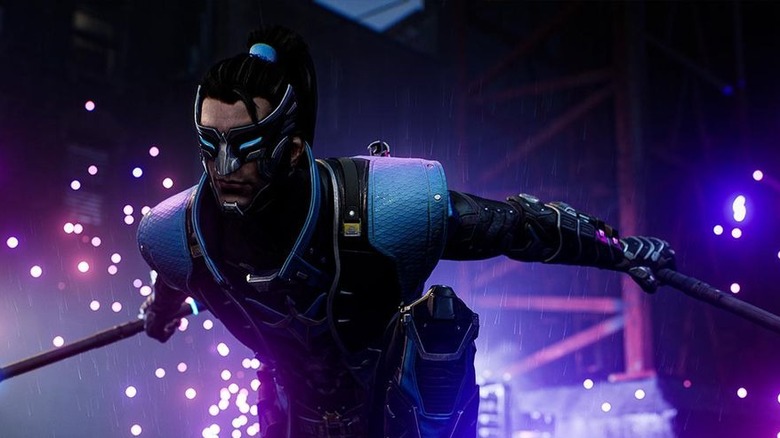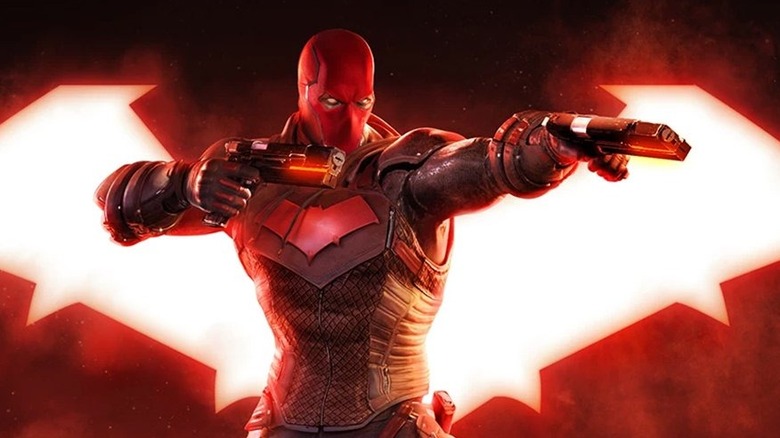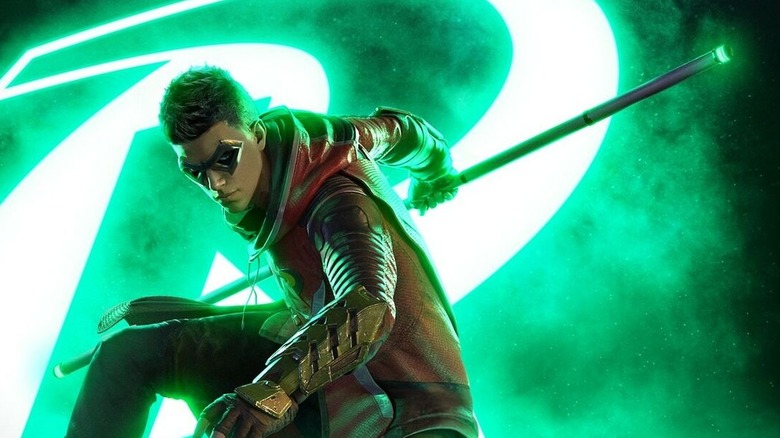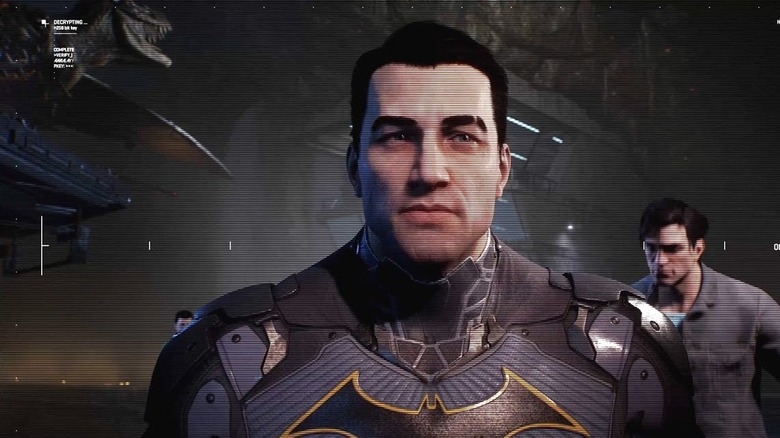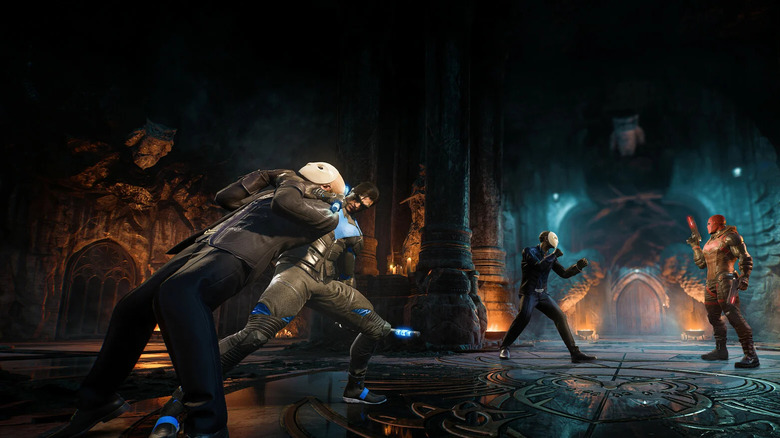Gotham Knights Ending Explained
"Gotham Knights" is the newest in a long line of Batman-centric video games. However, the game garnered a lot of attention when it was first revealed that it was set after Batman's death. The game instead follows the remainder of the Bat Family as they try to pick up the pieces and start defending Gotham City themselves. Throughout the story, players can swap between all four heroes — Batgirl, Robin, Nightwing, and Red Hood — to explore the open world of Gotham and tackle missions. Players can do this together as they team up to play in untethered two-player co-op.
The title also takes full advantage of the fantastic cast of iconic characters from throughout Batman's legacy. Each of the titular Gotham Knights also have their own stories and arcs that are explored as players punch, kick, and glide through the main story. So, if you are curious about what exactly happens in "Gotham Knights" — or need a refresher after beating it yourself — here is the game's ending explained.
The Gotham Knights are formed
The opening of "Gotham Knights" shows Batman sacrificing himself to defeat Ra's al Ghul by blowing them both up along with the Bat Cave. Doing so also automatically sends a video message to the members of the Gotham Knights, telling them that the Dark Knight has died, and that he needs them to pick up the responsibility of protecting the city. With that, Nightwing (Dick Grayson), Red Hood (Jason Todd), Batgirl (Barbara Gordon), and Robin (Damien Wayne) join together, operating out of the Belfry, a base Batman set up inside a clocktower.
With the help of Bruce's loyal butler, Alfred Pennyworth, the Gotham Knights then pick up an investigation that Batman was working on before his death. While they do, they each struggle with their own self-doubts regarding their new mission.
Batgirl is worried that she will be unable to measure up to the values and morality of Batman or her father, Commissioner Jim Gordon. Nightwing is unsure that he can make his own superhero mantle reach the same height as Batman's. Robin, Batman's son, is the youngest of the group and is naively idealistic about what being a hero really is. Finally, Red Hood feels ostracized by the superhero community after being brought back to life by the villainous League of Shadows' Lazarus Pit, leaving him unsure of where he stands. These questions and fears will follow them all the way through to the game's conclusion.
Gotham Knights' villians
While the Gotham Knights try to pick up Batman's final investigation, they run into a number of some of his most iconic enemies. The first they run into is Harley Quinn, who they discover was actually working with Batman while in prison. However, they also come into conflict with the likes of Talia al Ghul, Mr. Freeze, Man-Bat, Clayface, and the Penguin. However, the main antagonist throughout the game is the secret society known as Court of Owls.
With the Gotham Knights trying to replace Batman in Gotham, it makes thematic sense that they'd face off against some of his greatest foes. It sets up one the game's big throughlines — that the assembled team is greater than its solo parts — by showing them taking over where Batman left off. As they conquer some of the same challenges Batman faced, they are able to grow and develop in their own right, becoming the strong superhero team they had the potential to be all along.
The Court of Owls
The Gotham Knights' investigation ultimately leads to uncovering the Court of Owls. The Gotham Knights learn that the Court has operated from the shadows of Gotham for decades, pulling the strings behind its political leaders and development. Shortly after learning about the existence of the Court of Owls, the Gotham Knights also learn that the members of the society is getting close to finding a path to immortality thanks to a Lazarus Pit.
Shortly after this revelation, the Gotham Knights are approached by Talia al Ghul, the daughter of the late Ras al Ghul. She tells them that the League of Shadows is planning on destroying all of Gotham if that is what it takes to prevent the Court of Owls from achieving their goals. This pushes the Gotham Knights to infiltrate the Court, hoping to find a way to stop the plans that have been set in motion. While infiltrating a masquerade party, the Knights discover that the Court is led by none other than Jacob Kane, the uncle of Bruce Wayne.
Talia's secret plan
The Gotham Knights are ultimately successful in derailing the plans of the Court of Owls after exposing Jacob Kane as the leader of the society. However, the weakened state of the Court allows the League of Shadows to push in and seize the Court's Lazarus Pit for themselves. This is revealed to have been Talia's plan the entire time. She's merely been manipulating the Gotham Knights into helping her. However, that's only the start of her machinations.
When the Gotham Knights confront Talia at the Lazarus Pit, she reveals her full plan to them. She reveals that Batman was revived after his untimely end using the Lazarus Pit. After bringing him back to life, she brainwashed him to become the League of Shadows' newest leader, taking over for the deceased Ra's al Ghul.
Luckily, the Gotham Knights are capable of getting through to Batman and make him remember who he is. At the close of the battle, Talia and the League of Shadows flee the Lazarus Pit, allowing the Court of Owls to return for it. Not wanting the Lazarus Pit to be used ever again, Batman sacrifices his life again to crash his Batwing into it, destroying it and foiling the secret society's grand designs for Gotham.
Growing as a family
As the Gotham Knights face off against their numerous enemies, they also grow closer together as a team and a family. This is shown through various cutscenes that are sprinkled throughout the game, showing the characters interacting with one another and being genuine friends. These include scenes of Batgirl and Red Hood playing a dancing game as well as members of the team being mentored by Alfred.
These scenes do a great job of fleshing out the characters as well as showing them outside of their superhero personas. Early cutscenes in the game show conversations between them are fraught with tension. The team bickers almost constantly about decisions, strategies, and their complicated histories. This is especially true for Robin, who has a difficult time fitting in due to how young he is, and Red Hood, who feels like he isn't entirely accepted by the others. As the game goes on, however, players start to see more of the characters joking around with one another, building up each other's ideas rather than tearing them down, and working through their baggage — together.
Batgirl's ending
If players finish the game as Batgirl, they are treated to a cutscene wrapping up her story. As seen in this ending, she has grown to trust herself through her fight with the Court of Owls. The experience helps her believe that she is capable of living up to both the legacy left behind by Batman and her father. This is especially true here, as she has managed to foil a plot by Talia al Ghul, whose family was responsible for Batman's defeat.
The new confidence that Batgirl gains from completing the main story allows her to dedicate herself to stepping up as a symbol for all of Gotham. She broadcasts a message to the entire city, advertising the fact that she is taking up the responsibility of protecting the city from its villains. Taking such a public stance against crime also allows Batgirl to live up to the legacies of Gotham's previous crime fighters. Jim Gordon and Batman weren't just people, they were symbols — hence, the massive statue erected in Gordon's honor when he died. Batgirl has finally become a hero she thinks both Gordon and Bruce could be proud of.
Nightwing's ending
If Nightwing is used to complete the main story, players get a similar cutscene that instead wraps up Nightwing's character arc. This cutscene shows Nightwing instead being the one to broadcast a video message to all of Gotham. In his message, he takes on the responsibility of becoming the new face of Gotham's vigilantes. Most importantly, however, is that he does so while staying under and embracing the Nightwing persona.
This is particularly important for NIghtwing because of how much he struggles being in Batman's shadow throughout the game. This is not only because of how ubiquitous of a symbol Batman was in Gotham, but because of Nightwing's origins as well. Before Nightwing took that name, he was the first Robin. After years of working alongside Batman, he split off on his own to try and accomplish more.
Despite this, Nightwing was never sure of his ability to entirely replace Batman, placing pressure on himself to do so by behaving as close to Batman as he could. By the end of the game, however, he accepts that he can fulfill the role in his own way — as Nightwing — rather than trying to completely copy Batman's approach for himself.
Red Hood's ending
Destroying the Lazarus Pit in Gotham is a very big moment for Red Hood. After all, it was a Lazarus Pit that was used to bring him back to life, forcing him to never feel accepted amongst his peers, like he had an evil hidden somewhere inside him. When players achieve his ending in "Gotham Knights," however, he is shown growing beyond these concerns. Like the other Knights, he sends a broadcast to the city to take up the mantle of protecting Gotham.
This act shows a lot of growth for Red Hood, because it demonstrates that he is finally fully accepting the role of being a superhero. Publicly labeling himself in such a way shows that he doesn't care what others think of his origins or possible motivations. He is willing to do what it takes to protect others, regardless of what the wider public thinks of him, because he knows that his actions are what truly matter.
Robin's ending
Robin's ending in "Gotham Knights" follows the same template of his peers, but his message to Gotham takes on a very different meaning because of his story up to that point. With Robin's youth comes a very idealistic and fantastical view of how being a superhero is and what it really means. On top of this, he also feels pressure to rise up as Batman's most recent sidekick and continue Batman's legacy for himself.
In his message to the city of Gotham, he shows that he has matured and accepted himself for what he is. He no longer feels the need to be defined by his relationship with Batman, nor by his age and experience, and instead is confident enough to strive out as Robin to define his own persona as a superhero. The experience of working with the other Knights to take down the Court of Owls is also shown to have given him a more pragmatic view of heroism, as well as the maturity to be a more effective and serious superhero for Gotham.
The secret ending
After finishing the main story, players can interact with a picture of the Bat Family in the Belfry base to unlock a secret ending cutscene. This secret ending adds a great final note to "Gotham Knights" that sheds more light on the Bat Family as a whole, not to mention Batman's previous relationship with the Gotham Knights. The scene depicts Batman recording numerous messages to be broadcast to his proteges in the event of his death. Illustrating just how much Batman likes to plan ahead, each message covers a different potential cause of death that he has predicted.
In the middle of recording one, however, he is interrupted when the Knights come to retrieve him for a family dinner that he promised them. Batman resists at first, but the Knights are eventually able to coax him away from his computer to go and enjoy their time together. Seeing how they all interact as a group is a great way to add some context to the rest of the game that players just finished. It also shows how the Knights helped Bruce Wayne hold onto his humanity, rather than being entirely enveloped by his work as Batman.
Where Gotham Knights could go from here
"Gotham Knights" has a pretty open ending, so there are a number of solid options for where it could go next. Of course, the League of Shadows is still out there, but most obvious option would be for the Gotham Knights to face off against more of the long list of iconic villains from Batman. Despite the sizable list of villains in "Gotham Knights," there are still plenty that the team could fight in the future, including heavy hitters like the Joker, Poison Ivy, or even the Suicide Squad.
Another option would be for a potential sequel to "Gotham Knights" would be to flip the script and see how the villains respond to the death of Batman. Like Rocksteady's upcoming "Suicide Squad: Kill the Justice League," a sequel could put players in control of a team of bad guys, which would give a new and exciting perspective to this story. Since two "Suicide Squad" games so close together seems unlikely, the sequel could instead feature the Legion of Doom or the Injustice League. Heck, maybe the next game can make up for the lack of Joker and introduce the ridiculous Jokers of All Nations.
Whatever happens next, the Gotham Knights have become a strong enough team to face it.

